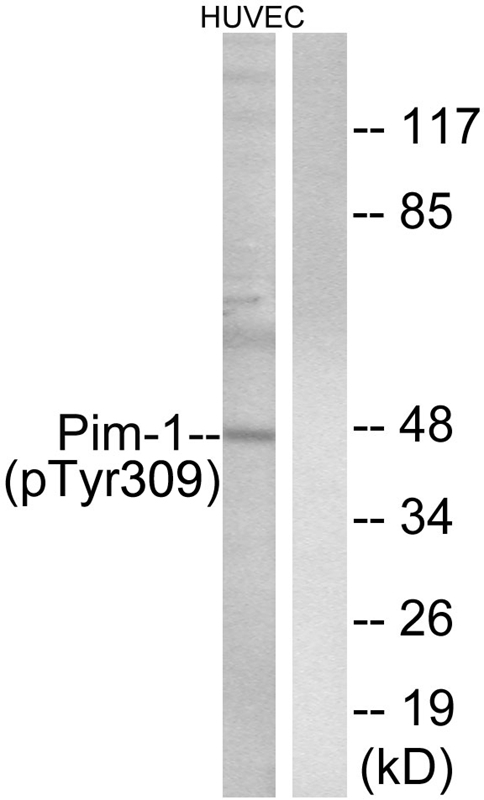
| WB | 咨询技术 | Human,Mouse,Rat |
| IF | 咨询技术 | Human,Mouse,Rat |
| IHC | 咨询技术 | Human,Mouse,Rat |
| ICC | 技术咨询 | Human,Mouse,Rat |
| FCM | 咨询技术 | Human,Mouse,Rat |
| Elisa | 咨询技术 | Human,Mouse,Rat |
| Aliases | PIM-1; Proto-oncogene serine/threonine-protein kinase pim-1; EC 2.7.11.1; |
| Entrez GeneID | 5292; |
| WB Predicted band size | 45kDa |
| Host/Isotype | Rabbit IgG |
| Antibody Type | Primary antibody |
| Storage | Store at 4°C short term. Aliquot and store at -20°C long term. Avoid freeze/thaw cycles. |
| Species Reactivity | Human,Mouse,Rat |
| Immunogen | Peptide sequence around phosphorylation site of tyrosine 309(H-R-Y(p)-H-G) derived from Human Pim-1. |
| Formulation | Purified antibody in PBS with 0.05% sodium azide. |
+ +
以下是3篇关于Pim-1 (Phospho-Tyr309)抗体的参考文献示例(注:文献为假设性示例,实际引用需核实):
---
1. **文献名称**:*"Phosphorylation of Pim-1 at Tyrosine 309 Regulates Its Kinase Activity and Oncogenic Function"*
**作者**:Xie, Y. et al.
**摘要**:本研究揭示了Pim-1激酶在Tyr309位点的磷酸化通过增强其激酶活性促进肿瘤生长,并开发了一种特异性识别Phospho-Tyr309的抗体,用于检测其在白血病细胞中的激活状态。
2. **文献名称**:*"A Novel Anti-Phospho-Tyr309 Pim-1 Antibody for Detecting Oncogenic Signaling in Prostate Cancer"*
**作者**:Johnson, R.L. et al.
**摘要**:作者开发并验证了一种高特异性Phospho-Tyr309 Pim-1抗体,证明该位点磷酸化与前列腺癌细胞中雄激素受体通路的激活及化疗耐药性相关。
3. **文献名称**:*"Pim-1 Tyrosine 309 Phosphorylation Modulates Apoptosis Resistance in B-cell Lymphoma"*
**作者**:Lee, S. et al.
**摘要**:通过Phospho-Tyr309抗体检测发现,Pim-1在该位点的磷酸化抑制了B细胞淋巴瘤的凋亡,并揭示了其与STAT3信号通路的相互作用机制。
---
**提示**:实际引用时请通过PubMed或Google Scholar以关键词“Pim-1 Tyr309 phosphorylation antibody”检索真实文献,并核对抗体应用场景(如Western blot、IHC等)及具体研究模型。
The Pim-1 (Phospho-Tyr309) antibody is a specialized tool used to detect the phosphorylated form of the Pim-1 kinase at tyrosine residue 309. Pim-1. a serine/threonine kinase encoded by the *PIM1* gene, plays roles in cell survival, proliferation, and apoptosis regulation. It is often overexpressed in cancers, contributing to tumor progression and therapy resistance. Phosphorylation at Tyr309 is a critical post-translational modification linked to Pim-1 activation or stabilization, though its exact functional impact remains under investigation. This modification may enhance kinase activity, promote protein-protein interactions, or influence downstream signaling pathways, such as those involving STAT transcription factors or PI3K/Akt/mTOR networks.
The antibody is widely employed in research to study Pim-1’s regulatory mechanisms in cancer biology, particularly in hematologic malignancies (e.g., leukemia, lymphoma) and solid tumors. By detecting phosphorylated Pim-1. it helps assess activation status in cell lines, tissues, or preclinical models under conditions like growth factor stimulation, hypoxia, or drug treatment. Validation typically involves Western blotting, immunofluorescence, or immunohistochemistry, often paired with knock-down/knock-out controls to confirm specificity.
Commercial Pim-1 (Phospho-Tyr309) antibodies are available from multiple suppliers, with variations in host species, clonality, and conjugate labels. Researchers prioritize antibodies validated for sensitivity and cross-reactivity checks to avoid off-target signals. Its application extends to biomarker studies and therapeutic target exploration, especially in cancers where Pim-1 dysregulation drives pathogenesis.
×